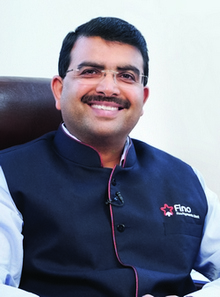Fino Payments Bank, which launched its operations recently, intends to make a difference with its acquired exposure to the rural masses as Fino Paytech. Rishi Gupta, MD and CEO, outlines the plan
Mohan: You had a momentous launch with 400 plus branches and 25,000 touch points on day What inputs had gone into this accomplishment? How do you plan to scale up this reach?

Rishi Gupta is aiming to make Fino Payments Bank the first profitable payments bank and he intends to have 100,000 touch points
Rishi Gupta: What we had as Fino Paytech were rural as well as urban branches. We knew our geographies and where our customers were positioned in these markets. However, when we started operations as a payments bank, we launched totally new branches, but located in the same geographies. Our old branches were small and largely present in residential areas. We closed them and brought the new payments bank branches into market areas. Our customers can access us through our physical network comprising of 422 branches and 25,000 access points through our merchant network. Our plan for the branches is to expand the footprint. For us, customer convenience is very important and towards that we offer them the choice of how they want to bank with us. One way of doing this is to expand the physical network and the other obviously is to offer digital platforms. While we have a strong branch network in place, we are now planning to expand our digital reach, especially through BPay, our mobile banking app. BPay enables simple, paperless and convenient banking that allows customers to make bill payments, recharges, fund transfers and buy insurance either through wallet or bank account. The user can also access the app through the debit card, which we have started issuing.
Fino Payments Bank has a clear advantage that it had a recognizable footprint already as an MFI and as a technology provider to the banking industry. How would you propose to leverage on these advantages to make an impact?
For us, everything will be digital, completely paperless. We have already set up a platform for eKYC, and we are using biometrics for transaction verifications. All our operations are being done on tab and web-based platforms, including interactions with our customers and our employees. Further, BPay will be a significant tool for customer interface. To me, technology is a critical factor in reaching out to the millions of customers in the country.
What are your business targets for the next 5 years? When would you be breaking even?
In the next 3 to 4 years we plan to have 100,000 touch points, 1000 plus branches and Rs10,000 crore deposits. More importantly, we would want to become the first profitable payments bank. The bottom line is very important to us. In today’s world money is being put in business but importance is not assigned to viability and sustainability of business. I feel that is very critical. We will continue to work in a manner where the profitability and the breakeven are achieved as quickly as possible. We intend to break even in the next 3 years.
The physical network will be expanded partly through our alliance with Bharat Petroleum Corporation, especially in remote areas.
How many customers does the bank have now? How many do you intend to add in the next one year?
There are 6 million customers who transact through the Fino platform today. Fino Paytech was already there and had a remarkable customer base. Some of these customers have already been converted as customers of the bank while some are still customers of Fino Paytech. We are slowly converting all of them as bank customers because there are certain formalities to be adhered to. For example, the bank needs to follow the requirement of minimum balance in savings account. We have fixed this at Rs 1000.
What are the plans for the branches, especially in rural areas?
The idea is to have 60% to 70% of our branches in the rural areas. Having said that there are pockets in urban areas where we have customers – like in Dharavi and Govandi in Mumbai and Rabale and Turbhe in Navi Mumbai. Fino as a payments bank is targeting customers who have income of say Rs 2 lakh to Rs 6 lakh a year spanning rural and urban locations. That is the mass market customer segment rather than random customers. We will continue to be very active in the rural as well as urban side to acquire and service customers.
Do you have tie-ups with other financial services institutions? What are the plans to introduce third-party products?
We already have multiple tie-ups. On the technology side, we work with FIS for the backend systems. We have others like ICICI Bank on partnership banking, IndusInd Bank on BC lending and ICICI Prudential, ICICI Lombard and Exide Life for bancassurance partnership. In addition, BPCL is there for distribution network. All these are big-ticket tie-ups.
You have a major handicap in that you cannot lend.
Payments Banks are allowed to be BCs for other banks. This enables us to undertake BC lending. Through this, we will be focusing on certain customer segments. One is joint liability groups, second is individual lenders who have migrated from JLGs and the third being MSME businesses.
Do you propose to offer higher interest rates in order to attract deposits?
We are paying only 4% interest. We do not intend to increase the interest rates. Our customer segmentation requires more service orientation rather than interest orientation.
How would you rate the competition? What are your advantages?
Four payments banks have started operations. It is only six months now and I would say we have to see next 3 years, because right now everyone is settling down, setting up the systems, establishing network, getting the priorities right. Our advantage is that we have been in this business for more than 10 years. We have gained experience, we have an insight of the market and we understand the customer segmentation. We had modeled our business on the way banking is done. Besides, we have a good team and we had adopted a phygital approach. And our cost structure is lower than others. We do business with 100% commitment. We also have committed distribution partnerships in place.
How would you see the role of the bank in a scenario where the government is pushing for less cash? How would you be promoting the concept?
If you look at the data for the last one year, there has been roughly more than twice the growth in banking mobile apps. In wallets alone, there has been a growth of more than 50% to 60%. There is a definite movement towards digital and people are comfortable using banking related apps. However, cash continues to be there in the system, so there is the invisible cost of cash from a customer point of view. But it’s the new generation that is fast adopting digital platforms for convenience. To that extent, the digital efforts the government is pursuing are becoming more and more popular. These are early days of the entire effort but I am sure the government will accelerate the digital transformation.

The only problem I see is that when we talk about digital, we talk about India and not about Bharat, the real India that resides in rural areas. Bharat is something which we are very keen to look at and my own trips to rural India gives me the confidence that the customer will move to digital albeit little slowly. But, over a period, they will imbibe digital applications and products in as good as a manner any other customer has done. It is a matter of time.
I am sure everywhere, including in the rural areas, the mobile will be driving factor. First, the physical services will come in and later these will be transformed into digital. People who are literate will move quickly to digital and others will also move over, over a period.
You have just announced that Fino Payments Bank will be collaborating with fintechs. What is the plan?
As a bank, there is technology which we can create and grow on our own. But, there is a fintech revolution happening all over the country. Many fintechs that have come up over the last few years provide specialized services like data processing and analytics around various platforms like IUX or API banking. We will be looking at some of the fintechs associated with the development of these products, some of which we are already using.
We look at banking as a huge opportunity. Every player is trying to target the same customer through digital channels. Our aim is to get to customers who need banking, because I feel those customers already serviced by banks are overbanked. Our focus will be on those who need good quality products and services. We feel we need to provide better products, better services and better access to these products and services. Eventually, we want to become a one-stop shop for all our customer target segments where we can provide them a whole range of services. We will start offering products like mutual funds in about a month’s time.
As a person who have watched the banking scenario for a long period of time, where according to you would the payments banks go from here? Would they graduate to become universal banks?
That is an important question for us. I do not know what will eventually happen. What I see is that somewhere payments banks scale up to the levels where they are properly and effectively regulated and they become full-fledged banks. RBI may come up with guidelines and specific regulations, which may probably make both payments banks and small finance banks into one entity – instead of two differentiated banks – like for example, a retail bank. As a retail bank, one can do several things. That is where the entire benefits to the customers will come. This may happen, but I do not know when and how. This is my own vision. There would be lot of regulatory requirements for these entities to fulfill. However, everything will depend on the regulator. This is my personal view.







